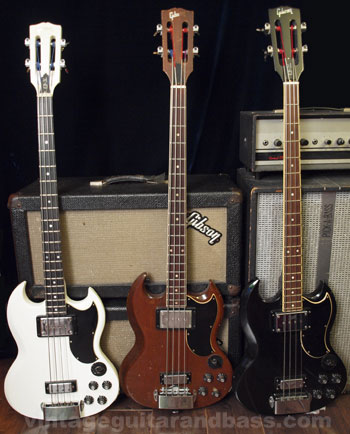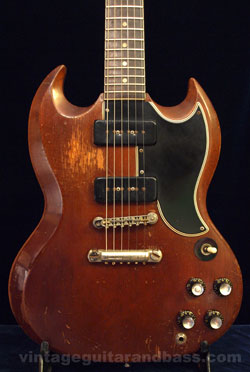
Fender and Gibson produced their very earliest electric bass guitars in the early 1950s, targeting the upright acoustic bass market. Both companies had their own ways of doing things, for a different type of customer and generally both stuck to their strengths. For the first decade, Gibson basses had a 30" scale, Fender basses 34"...

Today lots of people seem to think so. But this was not always the case and there are still plenty that disagree! One well-loved shortscale, the Gibson EB3 was a very popular bass guitar in the 1960s, especially towards the end of the decade when it was in the hands of charismatic bassists like Jack Bruce of Cream and Andy Fraser of Free. But at 30 1/2", the scale was still four inches shorter than the Fender Precision and Jazz basses, and even Gibson's own Thunderbird. So, as the decade ended, Gibson decided to offer the EB3 with a short or long scale neck. The whole solid body EB series was redesigned, the new bass sporting the 'slotted' or 'split' headstock more often seen on acoustic guitars, but with a choice of scale. Perhaps surprisingly these long scale EB3s never outsold their shortscale counterparts. Typical EB players wanted a bass that they could play fast melodic lines on, rather than simply sitting on the root.
But the longer scale EB-OL and EB-3L models are terrific basses to play however they were received in 1970. As with all EB basses the neck pickup can be a bit hot for some, but with some careful blending with the bridge, great tones are available. I've had the pleasure to restore (and play) three 1970/71 EB3L basses in the last few years, one remained in it's original walnut finish, one to black, and one to white. Shipping records and original documentation only suggest walnut and cherry as standard finish options, but other colours are not at all impossible, and these basses look pretty fine in these colours. Naturally they sound great too, and i've used them both live and in the studio! comment
In the beginning, Fender basses always had a 34", but with the rise of influential shortscale players like Paul McCartney, Bill Wyman and Jack Casady it was just a matter of time before an alternative was available from Fender. The brand had been pitched at younger players since the beginning, so it is perhaps surprising that it took so long to produce a bass more suited to smaller hands. In the end it wasn't until the Mustang and Coronado models were released in 1966 that Fender had their first 30" scale bass guitars.
Now I am a fan of short scale basses, they give you just that little bit more reach than long scale instruments making more interesting lines that bit easier. One bass I've been playing out this year (with UK live Hip-Hop crew True Element) is a 1969 Fender Mustang bass; in striking 'Competition Red' finish. The Competition Mustangs also came in blue (but weirdly called burgundy!) and orange, but all had the characteristic stripes in the top corner of the body. I'm particularly fond of mine, as it has the matching coloured headstock - a feature only seen for a short period around 1969.
These short scale basses don't take regular short scale strings though, being strung through the body. In fact few strings will fit; long scale are too long (potentially a costly mistake in broken strings if you try), and short scale are too short. I use flatwound strings and one of the few flatwound sets I could find that fitted were Rotosound RS77m - these are designed for a medium scale (32") bass. The Thomastik Jazz flats (set JF324) also fit. Got a favourite string set for a Fender Mustang? comment
It's a great bass... they are every bit Fender, and real fun to play. Whilst the Gibson pickup mentioned above is perhaps a little hot, the stock Fender Mustang pickup is perhaps a shade too weak. The modern day 'Pawn Shop' Fender Mustang reissues address this and actually have a humbucker fitted in the same position. I haven't tried one, but perhaps the best of both worlds?
Check out this great old clip of Talking Heads performing Psychokiller on the BBCs Old Grey Whistle Test from 1978; bassist Tina Weymouth getting a fantastic sound out of her Competition Mustang - although you might notice she's upgraded her pickups too, with an extra one in the neck position comment
There've been several Vox related page updates at vintageguitarandbass.com recently. Anyone following the site will know I find UK Vox guitars pretty interesting. It's true they don't make the best players in a lot of cases (in fact the early entry level guitars are barely playable) but some of the mid level guitars are what a lot of British guitarists cut their teeth on.
So what makes UK (JMI) Vox guitars different? Well JMI were predominantly an electronics company, and although not as good at actually building guitars as many other companies of the time, they were pretty good at devising innovative electronics. Although everybody knows about the Phantom and Mark (teardrop) lines, the earliest UK Phantom I and Phantom II are very different from the later Italian-built Phantom VI. The Phantom II, like the early Consort and Escort, is fitted with an array of tone switches which "introduce harmonic coverage hitherto unheard in the field of electric guitar music". There are very many other early UK models largely unknown, and rarely seen today. Check out the scan of the 1962 Vox 'Choice of the Stars' brochure showing a lot of these guitars, and have a closer look at some of the recently posted UK Vox photosets on this site. comment

I recently pickup up a very nice 1961 Gibson SG Special. Bought from a friend who needed a new bass rig for an upcoming tour more than an old SG. made at the legendary Kalamazoo factory, this is the first Gibson SGs ever made. To be fair it has seen plenty of action... it's had a refinish, but is still pretty battered, it's lost it's Maestro tremolo, got new tuning keys, a new bridge and stop tailpiece. On the plus side, it's neck is unbroken, it has the original 5 digit serial number, original P90 pickups, and 1961-dated Centralab pots. But above all it plays like melting butter. It has a nice wide (1 11/16" width at the nut) flat neck. And it's one i'm hoping to keep, and slowly restore; naturally i'll post my progress here. I'll be looking out for the original parts... although finding the original vibrola certainly won't be easy - it's the type fitted to the very earliest SG Specials (see the 1962 gibson catalogue). I'm not sure about changing the finish. It's already been done once, and it would look fine in a nice original cherry, especially to conceal the studholes once the non-stock tailpiece is removed comment

1963 Vox Shadow This is one of the really early UK Vox guitars shown in the 1962 catalogue mentioned above. The two pickup single cutaway version of the Shadow, and based on the Guyatone LG50 played by Hank Marvin of The Shadows before he moved to his red Stratocaster.

In 1972 Gibson put out a series of brochures for their higher end models; the Guitar of the Month Showcase. Featuring the Les Paul Recording, L-5CES, ES-175D, Super 400 CES, ES-355TD-SV and Byrdland

1961 Vox Stroller the single pickup version of the Vox Shadow (above), again with the early single cutaway body style. This one has the wider really early sixties pickup.

Three part article on selling vintage guitars, specifically selling online. Some steps to get the highest return when it's time to sell... identifying the guitar, finding out what it's guitar is worth, and advertising it for sale.
And don't forget you can now follow FlyGuitars / VintageGuitar website on facebook.
$2500
€4500
£3950
£157